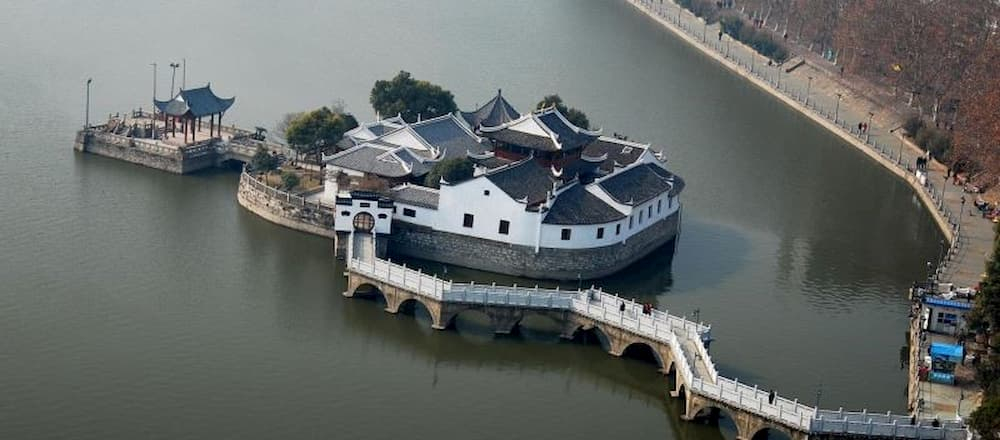
Chinese Pavilions, Terraces, Towers, and Chambers
Splendid
Chi Culture
Topic
Chinese Pavilions, Terraces, Towers, and Chambers
Pavilions, terraces, towers, and chambers have been the soul of Chinese architecture, which have witnessed the vagaries of history, recorded the winds of change, related the stories of the past, and have crystallized the vicissitudes of the years.
City infrastructure included many important elements; first and foremost was the city wall and its gate tower. The gate tower had many functions; troops could be quartered there, it provided an advantageous location not only for lookouts and sentries but also for archers. Its importance was underscored by the fact that it was also the venue for important official ceremonies. Similarly, gate towers on the fortresses protecting the passes were very important. They were built to be grand and imposing. Examples include the jianlou (archery tower) on Zhengyang men (Gate of Zenith Sun, a.k.a. Qian men), the gate tower at Shanhaiguan (Shanhai Pass) of the Great Wall in Hebei; the Wangjinglou tower on the Great Wall in Miyun, Beijing; the Jiayuguan (Jiayu Pass) gate tower of the Great Wall in Gansu, the Chenghailou Tower on Shanhaiguan in Hebei, the gate tower at the Liangzi Pass) of the Great Wall in Shanxi; the southern gate tower of Xi’an, Shaanxi; the Wuling Congtai terrace of Handan in Hebei, the Dianjiangtai terrace at Jiujiang in Jiangxi, and the Choubianlou tower at Aba in Sichuan.
The timekeeping that the bell and drum towers provided to the cities was indispensable; furthermore, they bore silent witness to the growth and changes of their cities. However, with advances in timekeeping technology, the bell and drum towers were no longer needed. Particularly fine examples are the bell and drum towers in Beijing, the large bell tower at Juesheng Monastery in Beijing, the drum tower at Zhangye in Gansu, the drum tower at Dongzhai in Guizhou, and the drum tower at Xi’an in Shaanxi.
Collecting books required skill in managing the collection, sorting and storing them, and preserving them for future generations. The buildings that housed collections of books were called cangshu lou (literally “storied building for storing books), and in English we may call them bibliotheca. The bibliotheca in ancient China developed along two parallel routes, one official, the other private. Renowned, extant bibliotheca include the Wenjin Chamber in Chengde, Hebei, the Tianyi Chamber in Ningbo, Zhejiang, and the Kuiwen Chamber at the Temple of Confucius in Qufu, Shandong.
Sightseeing towers and pavilions were built to complement and harmonize with the surrounding landscape. The Huanghe (Yellow crane) Tower is an example of this planning—its imposing silhouette is a pleasant contrast with the mighty Yangtze River. Other examples include the magnificent Yueyang Tower set against the vast Dongting Lake; the Zhichun (Heralding Spring) Pavilion which allows the viewer to appreciate all the scenery of hills and water of the Summer Palace at one spot; and the Wulong (Five dragon) pavilion which increases the gracefulness of the imperial garden of Beihai. Scenic places and their famous buildings have always attracted literati and scholars who would immortalize the sites in their writings. The poems about Huanghe Tower, the memorial to Yueyang Tower, the preface to the Prince of Teng’s Pavilion, and the antithetical couplet of the Canglang Pavilion have given an eternal soul to these places.
Jiaohua (enlightenment) towers had a glorious moment in history and the poems written about them have been universally praised. Examples of enlightenment towers include Zuiweng ting (Old drunkard’s pavilion), Tage’an Pavilion, Taibai Tower, Taoran (Happy and carefree) Pavilion, Jiaxiu (Most beautiful) Tower, Hainan Diyi (Number one in Hainan) Tower, King Wen’s Yanyi Terrace, the Wenchang Pavilion in Yangzhou, Jiangsu; the Pipa Pavilion in Jiujiang, Jiangxi; the Guanque (Stork) Tower in Yongji, Shanxi; the Kuixing (God of literature) Tower in Xi’an, Shaanxi; the Wangjiang (River viewing) Pavilion in Chengdu, Sichuan; the Haixin Pavilion of Cuihu (Green Lake) and the Daguan (Grand view) Tower both in Kunming, Yunnan; the Lan ting (Orchid pavilion) in Shaoxing, Zhejiang; and the Bayong Tower in Jinhua, Zhejiang.
During the spread and development of Daoism and Buddhism in China, numerous temples and monasteries were built. Some of them are exquisitely designed, including three at the Summer Palace: Foxiang (Buddhist incense) Tower, Tong ting (Bronze pavilion), and Wenchang Pavilion. Other examples are the Zhenwu Pavilion in Guangxi, the Xuguang (Rising sunlight) Tower at Pule (Universal Happiness) Monastery and the Dacheng (Great vehicle) Tower at Puning (Universal peace) Monastery both at Chengde, Hebei; Guanyin (Avalokitesvara) Pavilion at Dule (Solitary joy) Monastery at Jixian county, Tianjin, and Chenghuang (Tutelary god) Tower at the West Lake in Hanzhou, Zhejiang.
Palace architecture should be large-scaled, magnificent, and resplendent. Examples of palace architecture include: the Tian’anmen (Gate of heavenly peace) gate tower, the Wumen (Meridian gate) gate tower, the Changyin ge (Pavilion of pleasant sounds), and jiaolou (corner towers) in the Imperial Palace. Others are the Grand Theater House at Prince Gong’s mansion, the Wanfu ge (Pavilion or Hall of boundless happiness) in the Yonghe Temple (a.k.a. Lama Temple), the Fenghuang lou (Phoenix tower) at the Imperial Palace in Shenyang, Liaoning; the Long ting (Dragon pavilion) in Kaifeng, Henan; the Yuewang (King Yue) Tower in Mianyang, Sichuan; the Wuting (Five pavilion) Bridge at the Slender West Lake in Yangzhou, Jiangsu; the Longzhu (Dragon’s pearl) Pavilion in Jingdezhen, Jiangxi; and the Chikan Tower (a.k.a. Fort Provintia) in Tainan, Taiwan.



